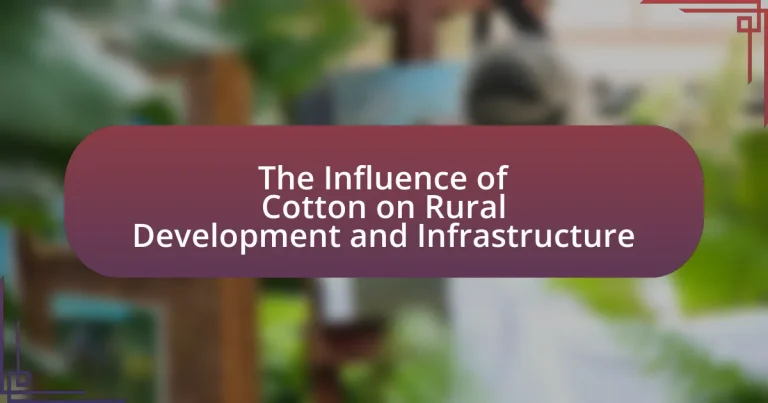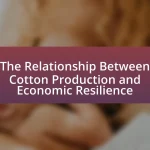Cotton is a crucial crop that significantly impacts rural development and infrastructure by providing economic opportunities and enhancing local livelihoods. The cotton industry generates employment in farming, processing, and distribution, particularly in countries like India and China, where millions rely on cotton for their income. This article explores the economic benefits of cotton farming, its role in job creation, and its influence on infrastructure development, including transportation and local market growth. Additionally, it addresses the social impacts of cotton cultivation, the challenges faced by farmers, and strategies to align cotton production with sustainable rural development goals.

What is the Influence of Cotton on Rural Development and Infrastructure?
Cotton significantly influences rural development and infrastructure by providing economic opportunities and enhancing local livelihoods. The cotton industry creates jobs in farming, processing, and distribution, which stimulates local economies. For instance, in countries like India and China, cotton cultivation supports millions of farmers and laborers, contributing to rural income and poverty alleviation. Additionally, the revenue generated from cotton can be reinvested into community infrastructure, such as roads, schools, and healthcare facilities, improving overall quality of life. According to the International Cotton Advisory Committee, cotton production contributes to the livelihoods of approximately 100 million people globally, underscoring its vital role in rural development.
How does cotton cultivation impact rural economies?
Cotton cultivation significantly boosts rural economies by providing employment opportunities and increasing income levels for farmers and laborers. In regions where cotton is a primary crop, such as in India and the United States, it accounts for a substantial portion of agricultural employment, with millions relying on cotton farming for their livelihoods. For instance, in India, cotton cultivation supports approximately 60 million farmers and their families, contributing to rural income and economic stability. Additionally, the cotton industry stimulates local economies through the demand for related services, such as transportation, processing, and retail, further enhancing economic activity in rural areas.
What are the economic benefits of cotton farming for rural communities?
Cotton farming provides significant economic benefits for rural communities by generating income, creating jobs, and stimulating local economies. The cultivation of cotton often leads to increased household incomes, as farmers can sell their produce at local and international markets. According to the International Cotton Advisory Committee, cotton production supports approximately 100 million people globally, with many of these individuals residing in rural areas where alternative employment opportunities are limited.
Additionally, cotton farming creates jobs not only in agriculture but also in related sectors such as processing, transportation, and retail. This diversification of employment helps to stabilize rural economies and reduce poverty levels. Furthermore, the revenue generated from cotton sales can be reinvested into local infrastructure, such as schools and healthcare facilities, enhancing the overall quality of life in these communities.
In summary, cotton farming serves as a vital economic engine for rural communities, fostering income growth, job creation, and infrastructure development.
How does cotton production create job opportunities in rural areas?
Cotton production creates job opportunities in rural areas by requiring a significant labor force for cultivation, harvesting, and processing. This agricultural sector employs thousands of workers, including farmers, laborers, and those involved in ginning and textile manufacturing. For instance, in countries like India and China, cotton farming supports millions of rural households, contributing to local economies. According to the International Cotton Advisory Committee, cotton production generates approximately 100 million jobs worldwide, highlighting its critical role in rural employment.
What role does cotton play in infrastructure development?
Cotton plays a significant role in infrastructure development by driving economic growth and providing employment opportunities in rural areas. The cultivation and processing of cotton stimulate investments in transportation, irrigation, and energy infrastructure, which are essential for supporting agricultural productivity. For instance, the establishment of cotton gins and processing facilities often leads to improved road networks and access to markets, enhancing overall rural connectivity. Additionally, according to the Food and Agriculture Organization, cotton farming can increase local income levels, which in turn supports further infrastructure investments, creating a cycle of development that benefits communities.
How does cotton farming influence transportation infrastructure?
Cotton farming significantly influences transportation infrastructure by necessitating the development of roads, railways, and logistics facilities to support the movement of cotton from fields to markets. The demand for efficient transport arises from the need to handle large volumes of cotton, which can reach up to 25 million bales produced annually in the United States alone. This production scale drives investments in infrastructure improvements, such as better rural roads and enhanced rail connections, to facilitate timely and cost-effective transportation. Additionally, regions with substantial cotton farming often see increased traffic and the establishment of distribution centers, further reinforcing the need for robust transportation networks.
What are the effects of cotton on local market development?
Cotton significantly impacts local market development by creating economic opportunities and enhancing agricultural productivity. The cultivation of cotton generates income for farmers, which stimulates local economies through increased spending on goods and services. Additionally, cotton production often leads to the establishment of processing facilities, which further contributes to job creation and infrastructure development in rural areas. For instance, in countries like India, the cotton industry supports millions of farmers and workers, contributing to a substantial portion of the agricultural GDP. This economic activity fosters a more vibrant local market, as evidenced by increased demand for local products and services, thereby reinforcing the overall economic stability of the region.

Why is cotton considered a key crop for rural development?
Cotton is considered a key crop for rural development because it significantly contributes to the economic stability and livelihood of rural communities. The cultivation of cotton creates job opportunities in farming, processing, and trade, which enhances local economies. For instance, in countries like India and China, cotton farming supports millions of farmers and their families, providing them with income and improving their quality of life. Additionally, cotton production often leads to the development of infrastructure, such as roads and irrigation systems, which further supports rural development. According to the International Cotton Advisory Committee, cotton contributes to the livelihoods of over 250 million people globally, underscoring its importance in rural economic frameworks.
What are the social impacts of cotton cultivation in rural areas?
Cotton cultivation in rural areas significantly impacts social structures by influencing economic stability, employment opportunities, and community dynamics. The introduction of cotton farming often leads to increased income for farmers, which can enhance local economies and improve living standards. For instance, in India, cotton farming has been linked to a rise in household income, with studies indicating that cotton farmers earn 30% more than non-cotton farmers.
Moreover, cotton cultivation creates job opportunities in both farming and related industries, such as textile production, which can lead to a shift in social roles, particularly for women who may gain employment in processing and spinning. This shift can empower women economically and socially, contributing to greater gender equality in rural communities.
However, the social impacts are not solely positive; the reliance on cotton can lead to social stratification, where wealth becomes concentrated among successful farmers, potentially marginalizing those who cannot compete. Additionally, the environmental challenges associated with cotton farming, such as water scarcity and pesticide use, can create social tensions within communities as they navigate resource allocation and health concerns.
Overall, while cotton cultivation can drive economic growth and social change in rural areas, it also presents challenges that require careful management to ensure equitable benefits for all community members.
How does cotton farming affect education and healthcare access?
Cotton farming negatively impacts education and healthcare access by diverting resources and labor away from these essential services. In regions where cotton is a primary cash crop, families often prioritize labor in the fields over sending children to school, leading to lower enrollment and higher dropout rates. For instance, a study by the International Labour Organization found that child labor in cotton farming can reduce educational opportunities, with children working long hours instead of attending school. Additionally, the focus on cotton production can strain local healthcare systems, as farmers may prioritize agricultural needs over health services, resulting in inadequate healthcare access. This is evidenced by research from the World Bank, which indicates that rural areas heavily reliant on cotton farming often experience poorer health outcomes due to limited healthcare infrastructure and resources.
What role does cotton play in community development initiatives?
Cotton plays a significant role in community development initiatives by providing economic opportunities and enhancing livelihoods. The cultivation and processing of cotton create jobs in rural areas, which can lead to increased income for farmers and their families. For instance, in countries like India and Burkina Faso, cotton farming has been linked to improved access to education and healthcare as families invest their earnings into these essential services. Additionally, cotton cooperatives often emerge, fostering community collaboration and empowering local farmers through shared resources and knowledge. This collective approach not only strengthens the local economy but also promotes sustainable agricultural practices, contributing to long-term community resilience.
How does cotton contribute to sustainable rural development?
Cotton contributes to sustainable rural development by providing economic opportunities, enhancing livelihoods, and promoting environmental sustainability. The cotton industry supports millions of farmers globally, particularly in developing countries, by generating income through both cultivation and processing. For instance, in India, cotton farming employs over 60 million people, significantly impacting rural economies. Additionally, sustainable cotton farming practices, such as organic cultivation and integrated pest management, reduce environmental degradation and promote biodiversity. These practices not only improve soil health but also ensure long-term agricultural productivity, thereby supporting rural communities’ resilience and sustainability.
What practices in cotton farming promote environmental sustainability?
Practices in cotton farming that promote environmental sustainability include integrated pest management (IPM), organic farming, crop rotation, and the use of drought-resistant cotton varieties. Integrated pest management reduces chemical pesticide use by employing biological control methods, which minimizes harm to non-target species and promotes biodiversity. Organic farming avoids synthetic fertilizers and pesticides, enhancing soil health and reducing water pollution. Crop rotation improves soil fertility and disrupts pest cycles, leading to healthier ecosystems. Additionally, drought-resistant cotton varieties require less water, making them suitable for arid regions and reducing the overall water footprint of cotton production. These practices collectively contribute to a more sustainable cotton farming system, supporting environmental health and resilience.
How can cotton production be aligned with rural development goals?
Cotton production can be aligned with rural development goals by enhancing local economies, creating jobs, and promoting sustainable agricultural practices. By investing in cotton farming, rural areas can benefit from increased income through both direct employment in cotton cultivation and indirect opportunities in processing and distribution. For instance, the International Cotton Advisory Committee reported that cotton farming can generate significant income for farmers, which in turn stimulates local markets and services. Additionally, implementing sustainable practices in cotton production, such as integrated pest management and organic farming, can improve environmental health and ensure long-term viability of rural resources. This alignment not only supports economic growth but also fosters community resilience and social development in rural areas.

What challenges does cotton face in influencing rural development?
Cotton faces several challenges in influencing rural development, primarily including market volatility, environmental sustainability, and socio-economic factors. Market volatility affects farmers’ income stability, as cotton prices can fluctuate significantly due to global demand and supply dynamics. For instance, in 2021, cotton prices experienced a sharp increase, but this was followed by a decline, impacting farmers’ financial planning and investment in rural infrastructure.
Environmental sustainability poses another challenge, as cotton cultivation often requires substantial water resources and can lead to soil degradation. The World Bank reports that unsustainable farming practices in cotton production can result in long-term ecological damage, which ultimately undermines rural development efforts.
Additionally, socio-economic factors such as access to education, healthcare, and technology hinder the potential benefits of cotton farming. Many rural communities lack the necessary infrastructure to support cotton production, which limits their ability to capitalize on market opportunities. According to a study by the International Cotton Advisory Committee, improving access to resources and education is crucial for enhancing the role of cotton in rural development.
What are the economic challenges associated with cotton farming?
Cotton farming faces several economic challenges, including fluctuating market prices, high production costs, and dependence on weather conditions. Fluctuating market prices can significantly impact farmers’ income, as cotton prices are subject to global demand and supply dynamics. For instance, in 2021, cotton prices experienced volatility, with a peak of around $1.50 per pound, which can lead to uncertainty in revenue for farmers. High production costs, including expenses for seeds, fertilizers, and pesticides, further strain farmers’ profitability; in some regions, these costs can account for over 50% of total production expenses. Additionally, cotton farming is highly dependent on weather conditions, making it vulnerable to droughts or floods, which can lead to crop failures and financial losses. These economic challenges collectively hinder the sustainability and growth of cotton farming, impacting rural development and infrastructure.
How do market fluctuations affect cotton farmers?
Market fluctuations significantly impact cotton farmers by directly influencing their income and production decisions. When cotton prices rise, farmers are incentivized to increase production, leading to higher revenues; for instance, in 2021, cotton prices reached a decade-high of $1.50 per pound, prompting many farmers to expand their acreage. Conversely, when prices fall, as seen in 2022 when prices dropped to around $0.90 per pound, farmers may face financial strain, leading to reduced planting and potential debt. These fluctuations can also affect farmers’ access to credit, as lenders assess risk based on market conditions, further influencing their operational capacity and long-term sustainability.
What are the financial risks involved in cotton cultivation?
The financial risks involved in cotton cultivation include price volatility, high input costs, and susceptibility to climate change. Price volatility arises from fluctuating market demand and global supply chain disruptions, which can lead to significant income instability for farmers. High input costs, including seeds, fertilizers, and pesticides, can strain farmers’ budgets, especially when crop yields are low. Additionally, climate change poses risks such as droughts or floods, which can severely impact crop production and profitability. According to the Food and Agriculture Organization, these factors collectively threaten the economic viability of cotton farming, making it a high-risk agricultural endeavor.
How can rural communities overcome challenges in cotton production?
Rural communities can overcome challenges in cotton production by adopting sustainable agricultural practices and improving access to resources. Implementing crop rotation and integrated pest management can enhance soil health and reduce dependency on chemical inputs, leading to more resilient cotton crops. Additionally, establishing cooperative models can facilitate shared access to machinery, seeds, and financial resources, which can lower production costs and increase efficiency. Evidence from the Food and Agriculture Organization indicates that cooperative farming can boost productivity by up to 30% in smallholder settings. Furthermore, investing in irrigation infrastructure can mitigate the impacts of drought, ensuring consistent water supply for cotton cultivation.
What strategies can be implemented to enhance cotton farming resilience?
To enhance cotton farming resilience, farmers can implement crop diversification, adopt sustainable agricultural practices, and utilize advanced technology. Crop diversification reduces dependency on a single crop, thereby mitigating risks associated with market fluctuations and climate change. Sustainable practices, such as integrated pest management and soil conservation techniques, improve soil health and reduce environmental impact, leading to more stable yields. Advanced technology, including precision agriculture and data analytics, allows farmers to optimize resource use and respond proactively to changing conditions. Research indicates that diversified farming systems can increase resilience by up to 30% compared to monoculture systems, demonstrating the effectiveness of these strategies in enhancing cotton farming resilience.
How can technology improve cotton farming practices in rural areas?
Technology can improve cotton farming practices in rural areas by enhancing efficiency, increasing yields, and optimizing resource management. Precision agriculture technologies, such as GPS-guided equipment and soil sensors, allow farmers to monitor crop health and soil conditions in real-time, leading to better decision-making. For instance, a study by the International Cotton Advisory Committee found that the use of precision farming techniques can increase cotton yields by up to 30%. Additionally, mobile applications provide farmers with access to weather forecasts, market prices, and best practices, enabling them to make informed choices that can further boost productivity.
What best practices can enhance the influence of cotton on rural development?
Implementing sustainable agricultural practices enhances the influence of cotton on rural development. These practices include crop rotation, integrated pest management, and organic farming, which improve soil health and increase yields. For instance, a study by the International Cotton Advisory Committee found that sustainable practices can boost cotton yields by up to 30%, leading to increased income for farmers. Additionally, investing in local processing facilities creates jobs and adds value to raw cotton, further stimulating rural economies. Access to education and training for farmers on best practices also plays a crucial role, as it equips them with the knowledge to optimize production and market their products effectively.





